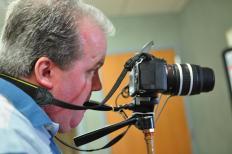






This is the third piece in a three-part series exploring the healing role of art in local hospitals. Read part one here and part two here.
 Jeremy AmbleIn a wheelchair, Jeremy Amble approaches his subject. He chews on a mouth stick to push the buttons of the camera, adjusts the aperture and other settings, and then bites on the remote trigger to release the shutter.
Jeremy AmbleIn a wheelchair, Jeremy Amble approaches his subject. He chews on a mouth stick to push the buttons of the camera, adjusts the aperture and other settings, and then bites on the remote trigger to release the shutter.
This is how Amble, a patient mentor at UW Hospital and Clinics, takes a photo.
Twenty-one years ago a car accident left him with a C4 spinal cord injury. Confined to a wheelchair and with lost finger functioning, he had to bury his long-term passion for photography, until two years ago when he met Sarah Petto, the artist in residence at the hospital.
Amble and Petto worked together and developed adaptive equipment for physically challenged patients to take photographs. And Amble embarked on his own journey toward artistic creativity.
Amble loves nature, takes photos of his own children at home, and enjoys post-editing to make the photos more artistic.
Though he is sometimes frustrated by his limitations of angle or distance to the subject, Amble remains positive: “It’s not going to affect my day,” he said.
For him, almost every picture is inspiring. And Amble enjoys the sense of creativity and independence.
Now Amble set up a camera session with Petto for patients, family members, and staff in the hospital. People drop in the class, with whatever they have, including point-and-shoot cameras or iPhones.
“There is no pressure,” said Amble.
Every week he and visitors play with different angle, lighting, and composition, experimenting, enjoying the moment of creation. Amble believes that his experiences can inspire people, showing that even with a physical limitation, one can still have fun with cameras, do something independently, and enjoy what life has offered.
|
|
|
Welcome to the Madison Commons, a website designed to provide news and information about all of Madison's neighborhoods and a crossroads for the discussion of community issues. The name comes from the idea of a village commons, a place for news, talk, debate, and some entertainment, too, that's open to everyone.
All rights reserved. Read more about the Madison Commons and its partners.

